
How Do Volume and Tone Pots Work For Guitar?
Volume and tone pots play a crucial role in your guitar’s sound and setup. By learning more about these pots, you can ensure you choose the right type and value for your instrument.
Table of contents
THE BASICS OF POTS
A potentiometer, commonly referred to as a “pot,” is a type of variable resistor. By turning the knob on the pot, you change how electricity flows through it. Inside the pot is a circular resistor strip, known as the “element,” which is contacted by a component called a “sweeper.”
When you turn the knob, you adjust the position of the sweeper along the resistor strip. This adjustment allows you to select how far the electricity must travel on the strip before reaching its output.
A potentiometer functions as an “L-Pad,” an electrical device that performs two tasks simultaneously. It introduces series resistance and creates a short circuit across the signal. This short circuit helps dampen high frequencies in the signal, even when the pot is set to its maximum value, or “10.” For example, with a 250K pot, you can select any resistance value between 0 and 250K.
Internals Of A Pot
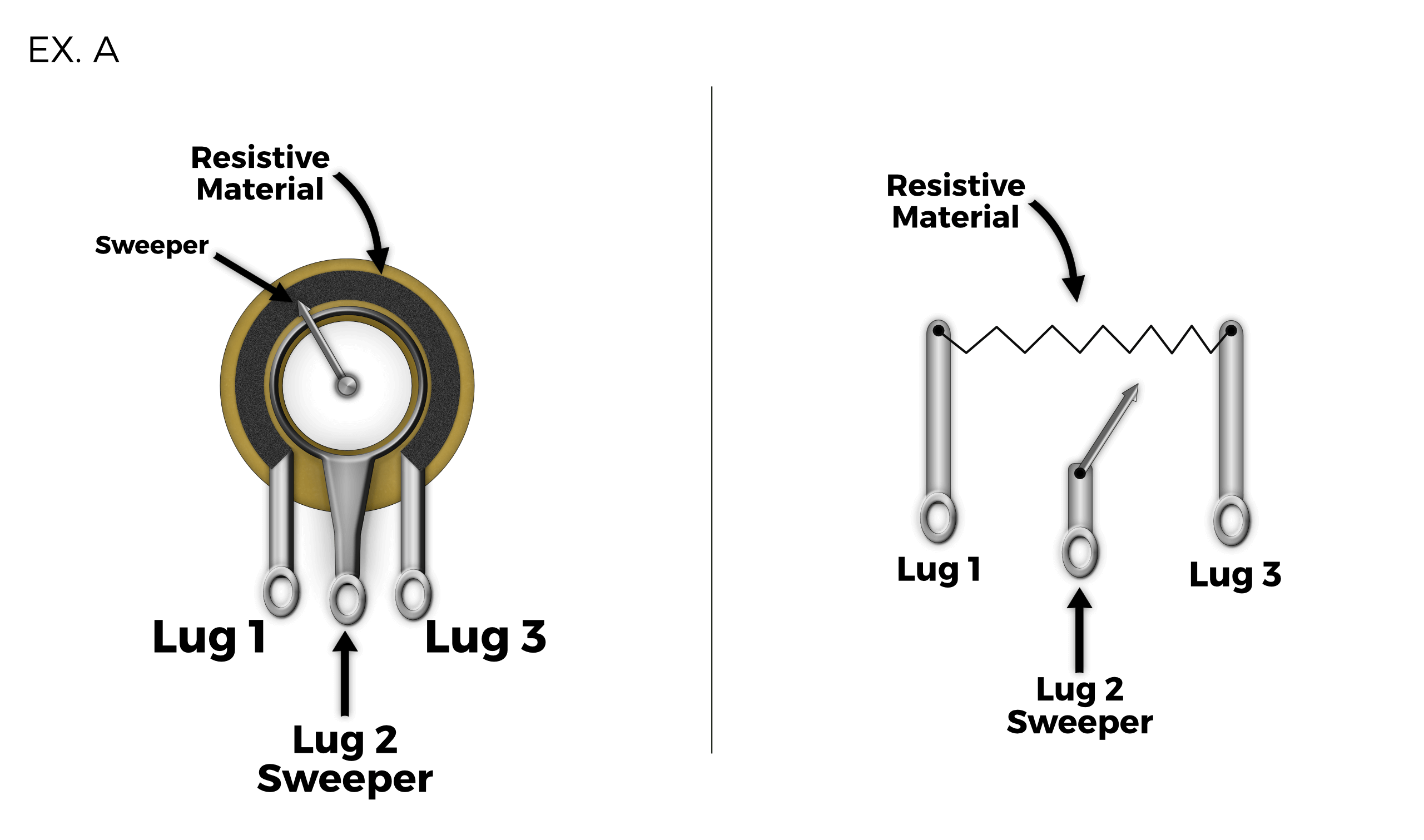
In Example A, you can see that the pot consists of a resistance strip made of resistive material and a sweeper. The sweeper moves across the resistance strip to achieve the desired level of resistance.
For a 250K pot, the resistance measured at the Start of Sweep (Lug 1) and End of Sweep (Lug 3) is approximately 250K, while the middle lug serves as the sweeper. This mechanism allows you to obtain variable resistance! It’s important to note that manufacturers have tolerances; in reality, the resistance might be around 243K.
You can verify the resistance of your pot by taking an ohm reading between the two outer lugs. The pot serves as a foundation for various applications. From volume controls to tone adjustments, let’s explore a few variations to see how we can utilize a single pot in multiple ways.
WHICH POT TO CHOOSE – 250K OR 500K?
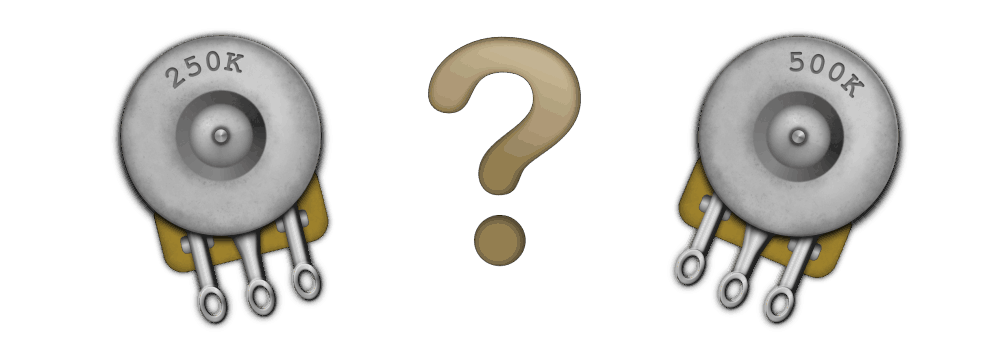
BRASS TACKS:
Single Coil pickups and brighter-sounding pickups (think Strat, Tele) use 250K Pots.
Darker-sounding pickups (P-92, 43-Gauge Big Single, P-90’s, and Hum-Cancelling P-90’s) use 500K Pots. (Read more about choosing between 250K and 500K pots here)
WHY?
The higher resistance pot won’t send your high frequencies to ground as quickly as 250K pots do. They sound brighter and allow more high frequencies to pass through the Pot. 250K Pots will send more high frequencies to ground, making the pot sound a tad darker.
Using the correct pot value is pleasing to the ear – we don’t want muddy sounding humbuckers, or piercing single-coil pickups. So, our pots help compensate and shape the tone right from the get-go.
There are Pots in the middle – we sell 300K Pots as well, which are a little brighter-sounding than 250K pots.
LINEAR VS. AUDIO TAPER POTS
We get asked about Linear and Audio Taper pots a lot. Despite choosing which resistance of Pot to go with, there are two types of Pot “Tapers.” Taper refers to how the sweep acts and sounds. Is it smooth and gradual? Or, quick and abrupt?
LINEAR POTS:
Linear pots are, well, linear. Imagine a straight line on a graph: electronically, your wiper and taper is just like that – a straight line. You would think that this is the end-all, be-all of pots, right? Well, the human ear doesn’t hear that way (there’s a thing called the Weber–Fechner law).
What happens? 90% of your perceived signal change is found in the first 25% of the turn. That means you turn your Pot a little bit, and the bulk of the change happens right there. Not very useful for specific applications.
AUDIO TAPER POTS:
Audio Taper pots are different from Linear pots as they are logarithmic. Imagine that straight line, only curved in the middle. The result is an exponential increase or decrease in resistance as you turn the Pot.
What happens? You experience a smoother change when you turn the Pot. This means that you can perceive a 50% loss in volume at the “5” mark!
We prefer Audio Taper Pots for Volume and Tone, but you can always experiment!
SPLIT SHAFT OR SOLID SHAFT
This is all about the knob! If you have plastic knobs like a Strat, those require Split Shaft pots – you can simply slip the plastic knobs on.
Metal knobs with a set screw require Solid Shaft pots. For Metal knobs, you have to tighten the set screw onto the post.
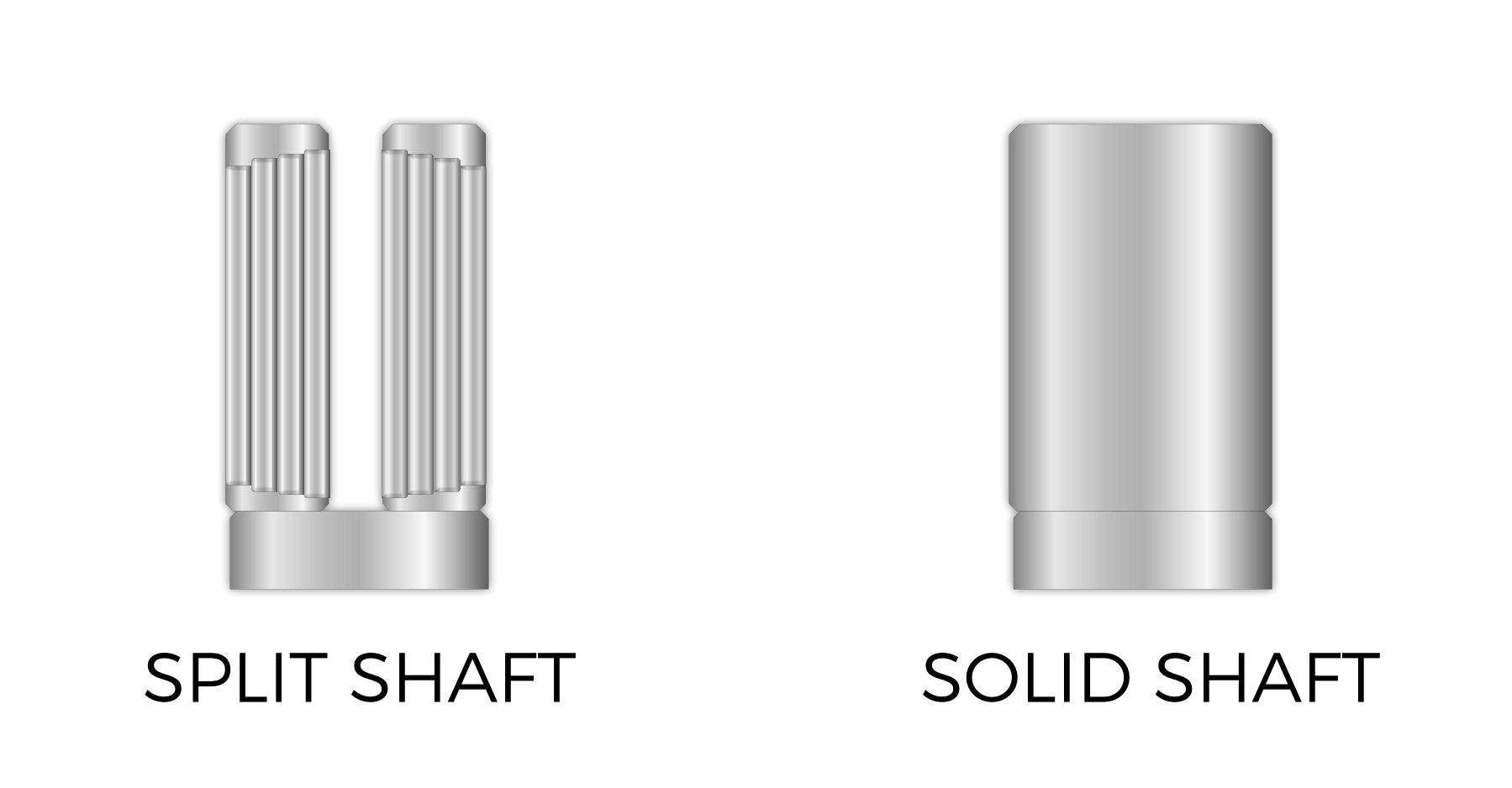
Consequently, this is really hard to do with a Split Shaft, and you might break part of the shaft doing so. A quick fix is to use a “sleeve” which is a metal tube that goes over the Split Shaft, basically converting it to a Solid Shaft pot.
VOLUME POT BASICS
Now that we’ve covered some of the most frequently asked questions, let’s dig into how pots work. Let’s start with Volume Pots:
On a Volume Pot, a basic set-up is this for a Gibson®, Strat® or Tele®:
- Input = Lug 1
- Output = Lug 2
- Ground To Casing = Lug 3
The third lug connects to ground. That means as the sweeper moves towards the grounded lug, more of your signal is sent to ground. When the pot is turned all the way counter-clockwise, all of your signal is being sent to ground, thus, no volume! Let’s illustrate how this works:
Volume Control For Entire Guitar
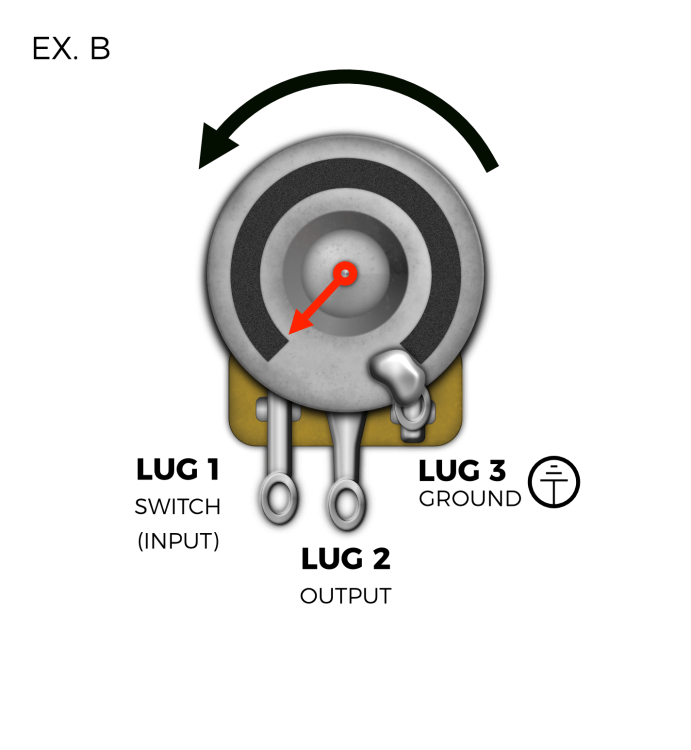
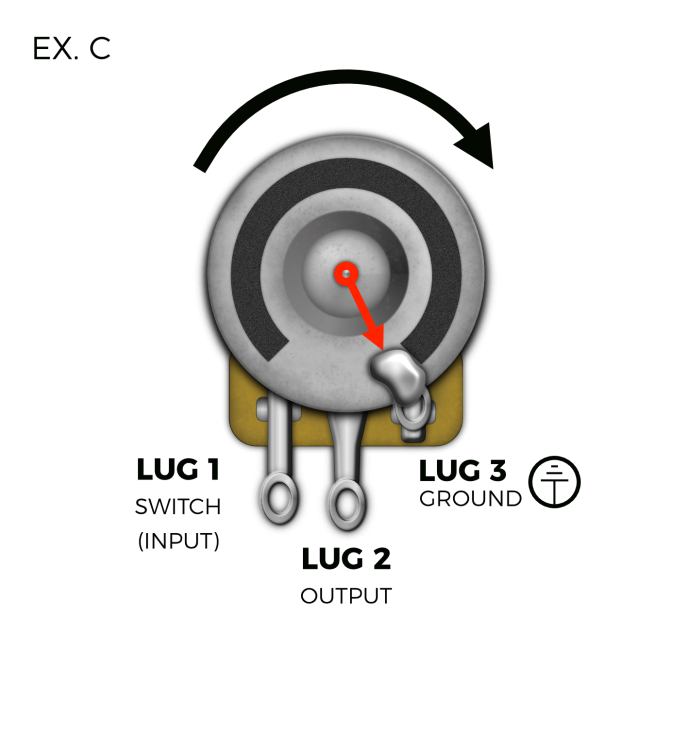
In Example B, your input and output are basically connected – zero resistance. Therefore, all of your signal is passing through the output lug.
In Example C, The sweeper moves towards the grounded lug – which means some of your signal is being sent to ground. When the sweeper is turned all the way counter-clockwise, no signal would come through your amplifier – you’ve connected “output” with ground.
Volume Control For Individual Pickups
You can easily control the individual pickup volume by changing how you wire up a Volume Pot. Les Pauls and Jazz Bass wiring configurations get wired like this:
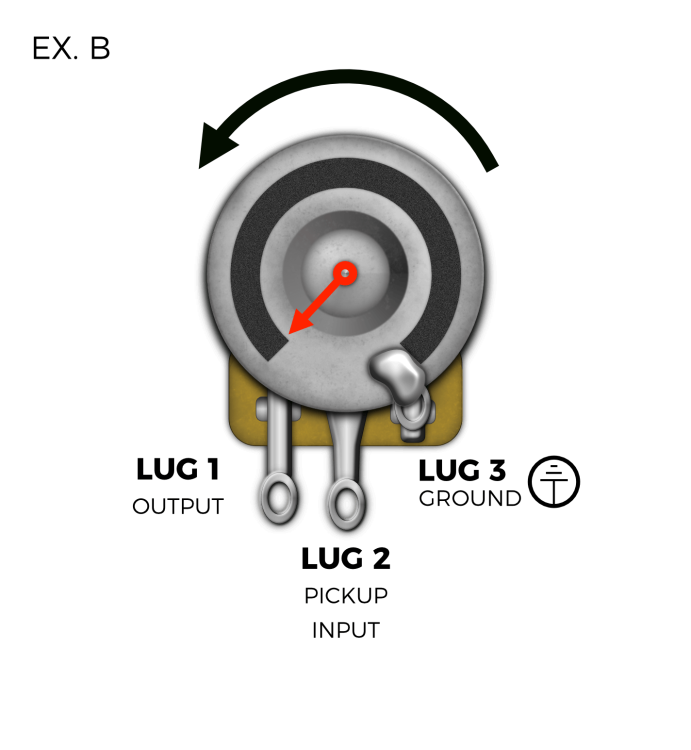
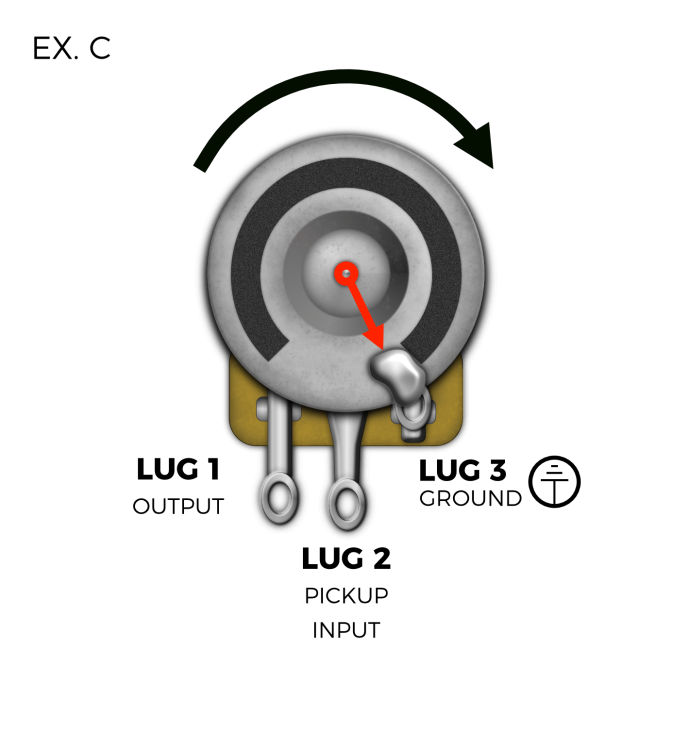
This wiring allows you to control the volume of each individual pickup, rather than the overall volume of the guitar. To set it up, simply change the order of the lugs: make Lug 1 the output instead of the input. The sweeper will be connected to the pickup instead of the output jack. Consequently, instead of connecting the output jack to ground, you will connect the pickup to ground. This setup works particularly well for Jazz Basses or P-J Basses.
TONE POT BASICS
A Tone Pot is essentially a standard potentiometer with a capacitor soldered to it. While it functions similarly to a volume pot, there are key differences.
Instead of sending the entire signal to the ground, the tone capacitor allows only a portion of the signal to be grounded. Tone capacitors are designed to let high frequencies pass through while resisting or rejecting low frequencies.
TONE CAP VALUES:
The value of the tone capacitor (e.g., .0025?F, .02?F, .1?F) determines the cut-off point for high frequencies. A smaller value, such as .0025?F, will allow the least amount of highs to pass through. When you roll off the tone, you’ll notice a subtle change in your high frequencies, but there’s a limit to how dark your guitar can sound.
In contrast, a higher value tone capacitor, like .1?F, will roll off more high frequencies, reaching into the high midrange. This will produce the darkest and deepest roll-off with larger value capacitors.
Combining a Tone Pot and Tone Cap
- You turn your Tone Pot counter-clockwise.
- Your signal starts to pass through the Tone Cap, which connects to ground. (Example D)
- The Tone Cap will reject the low frequencies, allowing the high frequencies to get sent to ground, thus making your tone sound darker.
See below for an illustration:

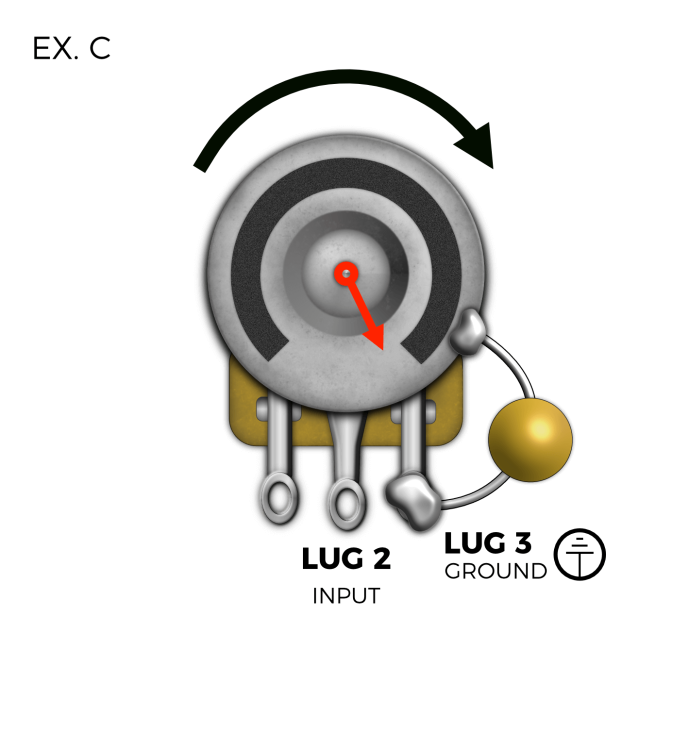
As you can see from the above examples, the tone pot works pretty similarly to the regular Volume Pot. This time, we have our Tone Cap to help us fine-tune our tone!
WHAT IS A NO-LOAD POT?
Before we get into No-Load Pots, let’s talk about “Load”:
The definition of Load in terms of electricity is anything in a given circuit that “consumes” energy as opposed to sourcing (providing) energy.
Even on “10”, your tone pot is still “sucking up” electricity. The Sweeper (Middle Lug) is still technically on the Resistance Strip, which draws power from the Volume Pot.
On a No-Load pot, there is a break on the Resistance Strip where the Sweeper is taken completely out of the circuit. Using a No-Load Pot will make your pickups sound a little more “full-throttle”. They might sound a little bigger, fuller, with added bass and treble. This is all personal taste, and we can take them or leave them, depending on the guitar.
WHAT IS A BLENDER POT?
Lindy has installed a Blender Pot on almost every 3-pickup guitar he owns. A Blender Pot is a type of No-Load Pot that will “Blend” between two pickups that it’s wired to.
It’s a useful mod that allows you to get a lot of tone options – like Telecaster tones out of your Strat. While the Bridge is selected, turning the Blender Pot will blend in the Neck.
To illustrate a simple installation of a blender pot, check out this wiring diagram here.
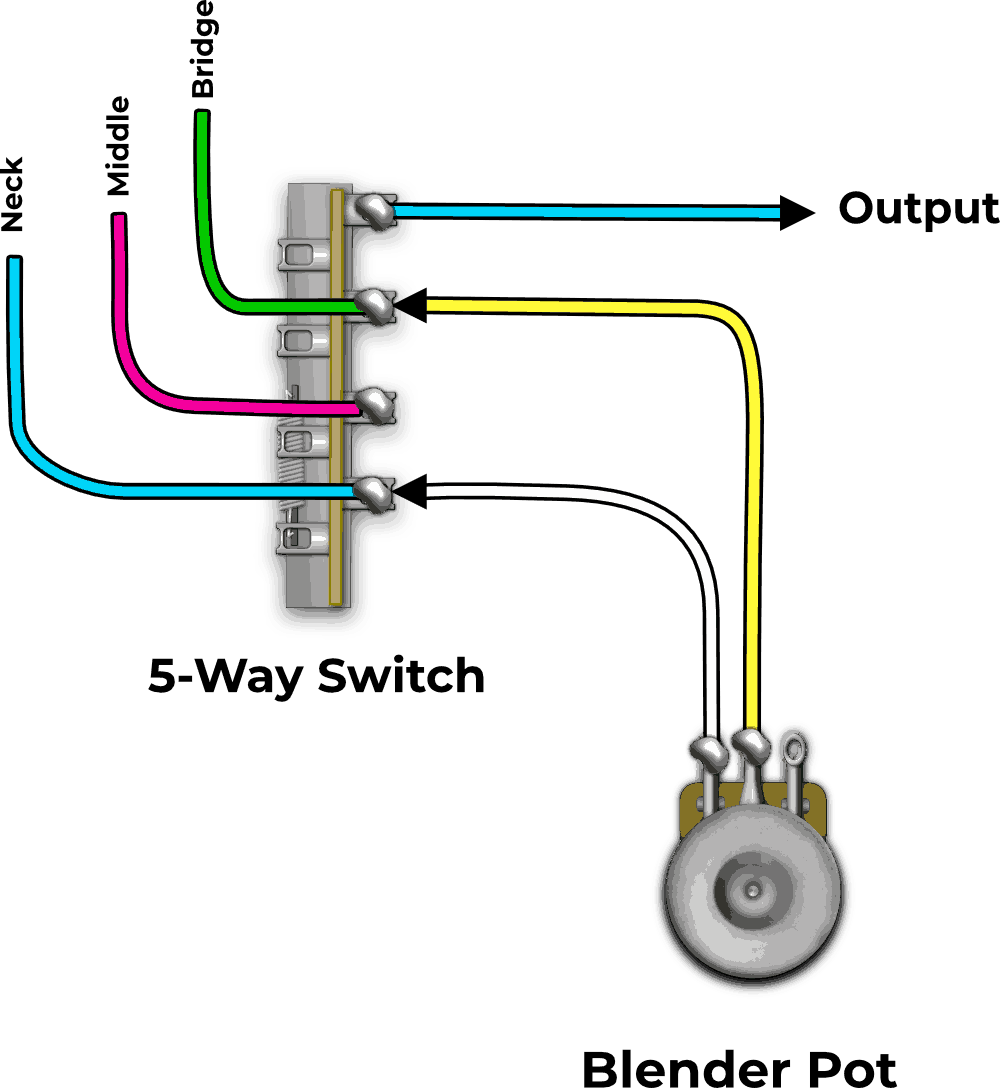
Whew. Now you have a grip on the basics. I hope this article has been helpful. Now use your guru knowledge to create your own unique tonal combinations, and make sure you choose the pots that will work best for you.
Comments
93 Comments For This Post
Leave A Comment
Want to chime in to the conversation? Please do so! Please respect others.

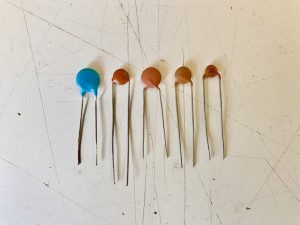

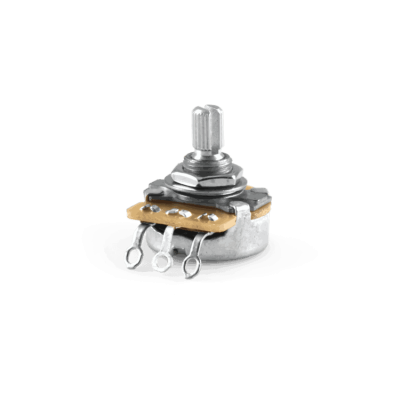
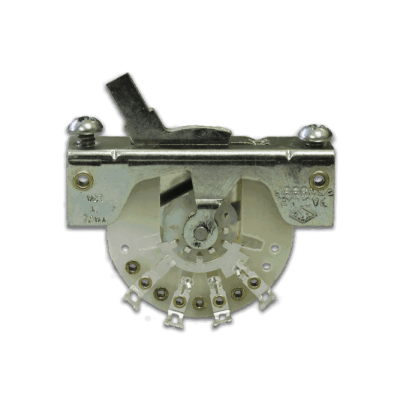
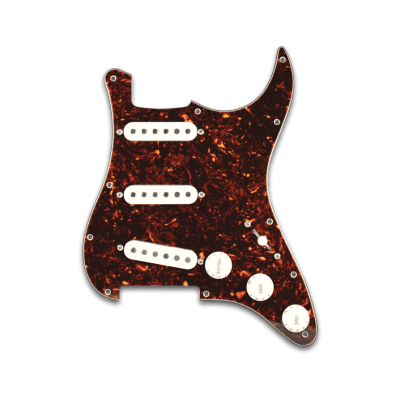
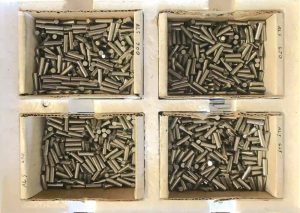
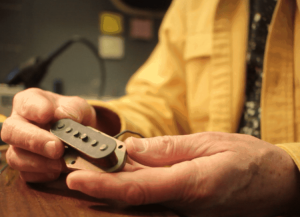

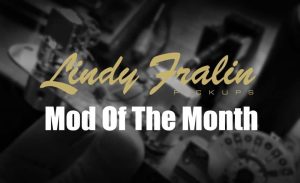

A ‘H S’ Strat (a Samick brand with just 2 pickups and a parallel/series toggle switch) had 2 * 500k pots in it V=500KA and T=500KB types. I heard no tone change from the guitar in either of my amps, yet the guitar tech could hear and re-create it with his table-top amp. I replaced the bridge pot with a 250KA pot and wired it just as it was before. But no change. I can’t understand why the tone pot seems to do nothing on my 2 amps, yet seems fine with a cheap table-top amp. I must be missing something…
Tyler & Lindy Fralin, Thank you for this article on Blender Pots. I am going to order one today and install it in my Strat that I have 3 Fralin’s in — all Blues Specials. I love these pickups. Thanks for making some of the best pickups in the world. Can’t wait to install the blender pot!
Great article and clear as a bell. I have a generic Les Paul wiring question that’s bugged me for years.
– Tone pot terminal #2 is the input, yet most schematics have the cap attached to the #1 and then ground #2 to the case. You show it the other way around which I agree with. I guess it doesn’t matter electrically…but I’ve always wondered why people use the correct tab to ground the Volume pot but then run the signal ‘backwards’ through the Tone pot. Never made sense to me.
Hey William,
Check out our latest article on that subject, hopefully it will clear it up. I believe what you are referring to is ’50s wiring? Like this here:
Hello Tyler, thanks for a helpful article. I am a Fender guy with two Telecasters. I have played a Tele deluxe with a separate volume for each pickup and it works as expected. Also my Dad had a Gretsch, which worked the same way (if I recall). You can use the two volume knobs to blend between the pickups for a good balance of bridge and neck.
I just got an Gibson ES-339 and the volume knobs do not behave the way I’d expect. With the pickup selector in the middle position (both pickups), the guitar goes completely silent if either knob is turned all the way down. Even at half the overall volume is greatly reduced. This makes me think somehow something is wired in series rather than parallel. Is that correct? Is this normal behaviour for Gibson guitars?
Thanks for any help!
Hi I just purchased a Solid shaft, 1 meg-ohm pod, will this work and sound good with a zebra humbucker?
Hey Bruce,
1 Meg pots are some of the brightest pots available, and you’ll get plenty of top-end out of your humbucker. If you’re looking for the most top-end, you’re going to like what a 1Meg pot provides. If it ends up being too bright, change to 500K.
Hello Tyler
Would like to know if it is possible to use a combination of a soap bar P90 neck with a humbucker bridge that can be split? Is it possible to then have combinations of single P90, P90 and Humbucker, just humbucker, humbucker split into two single coils, humbucker split to single with P90? If this is possible I was wondering if you could tell me how it would need to be wired, this way I could have the best of all 3 different types of pickups.
Thanks for all the great info you guys are putting out, extremely helpful especially for a newbie builder such as myself.
Best Regards
Maurice
I’m a lefty guitar player. Half my guitars come with left handed pots, the other half with right handed pots. It would be nice to mention how to identify the difference if you have a multimeter… What the resistance should read when the knob is at 5.
Very good article. Thank you, Tyler and Fralin!!
On a related topic, low impedance vs. high impedance pickups. For years, all I ever saw Les Paul playing were low impedance “studio” Les Paul guitars. I’ve often wondered why the industry differed from Les on this point. If your article translates to pickups, too, then Les’ guitars all sounded darker than a normal high impedance Les Paul? is that a correct assumption?
P.S. Second line of the article, I think you meant to say “…fine-tuning your tone” not “fine-tuning your tune”? Either way, works. Lol
Hello, I am currently building a telecaster custom. I purchased the Fralin WR Humbucker and the Fralin Blues special for the bridge. Each pickup has it’s own volume and tone control knobs. Do you have any suggestions about what kind of pots/ caps to use. I was planning on using 250k pots for the bridge, but I ‘m unsure if I should use a 300k or a 500k pot for the Humbucker. Does Fralin have a recommended pot for the humbucker? If I use a 300k pot for the tone should I use a 300k pot for the volume as well?
Hey Matt,
We’d suggest a 500K pot for the Wide Range Humbucker and a 250K pot for the Bridge. We like .02 caps, most of the time – but this is personal preference.
Tyler
Outstanding primer on pots – thank you for explaining all this in such a straight forward way!
Hey Ty,
I’m with Paul above!
I found the exact opposite with straight forward Audio Taper pots for volume. 80% of the taper rolls off between 10 and 8 and the remaining 20% rolls off from 8 to zero. And way too front loaded for dialing in and finessing tones, especially in a dual Humbucker setup each with V&T of their own, but tied together. Think Gibson LP. But the straight forward AT pots thrive for the Tone Pots. Some manufacturers have a custom audio taper that rolls off slower and when people install these, they can’t believe they waited so long. Linear Taper Pots for volume and Audio Taper post for tone are really the ultimate in a Gibson setup.
Here’s a post at a website called My Les Paul. This guy did all the work to prove what the reality is. I suggest you read and listen. It will definitely broaden your knowledge to the real facts. Say Hey to Lindy. He helped me with his Jazz Bass Pups years ago. GREAT GUY! He’ll remember me from our Hafler discussions. Hopefully he found one with a QUIET fan.
GOOD STUFF—–> https://www.mylespaul.com/threads/volume-pot-taper-count-ups.225271/
Hi, I need a little advice on wiring, I have a set of sss stacked pups, they are 13.7/6.3 k, do I use the 250k pots? I want to set them up to split the coils as well. Can I do this with a 5 way switch or will I need push pull pots, I only want 1 vol,1tone . Thanks
Depends on your pickup manufacturer – I can’t comment on that. I would check with your original manufacturer’s recommendations for pot value.
Should/can I put 250,or 500k pots in my player series Jaguar to reduce some of the brightness.
Sure, Jordan – you’ll need to see what you have installed already. 1Meg? Try 500K. 500K? Try 250K.
Tyler
Hi Jordan, I am attempting to play jazz and got a player jag because the shortscale neck comports with my short fingers. Fender says the jag has 500k pots and my luthier swapped the cap to warm the tone. In addition, I put on flatwound 11 strings and use a heavy jazz pick. I roll off the tone on the neck pickup and play clean thru a Roland cube for a warmer, rounder jazz tone.
p.s. google Joe Pass playing a jag on YouTube.
Tyler,
Could you explain a few things for me? I have 3 Fralin single coils in a backside rout Tele. They were not the hottest pickups. I had to get long shaft pots. I have a 250K or a 500K volume(whichever is needed), and 2 500K tone push/pulls. I am using a 10 way Freeway switch. I wanted to put different caps(.022 +.047) on the #1 tone P/P for standard Strat sounds plus a little darker. The Freeway switch has 5 pickup combinations, then you shift gears and it has 5 more. I wanted the #2 tone control to work with the second 5 positions.(what caps do you suggest?) On the second 5 positions I wanted hum bucker combinations.Bridge/middle/—bridge/neck,— middle/neck, all 3 in series, and maybe one in parallel.
1. Can you take the output from the Freeway switch and send it to a spdt toggle one side to tone control #1(other to tone control #2) then to volume bypassing the #2 tone control? Would I need a 500K resistor on first P/P. to make it 250K for a straight strat sound?
2. Can you take the 2nd output from the freeway switch flip the spdt toggle switch/bypassing the #1 tone control and send signal to the #2 tone control when using the hum bucker combinations? Then the #2 tone P/P would be 500K for the hum bucker combinations?
3. What effect will the 500K tone pot on the hum buckers have with the 250K volume?
4 In my set of Fralin pickups is the middle pickup reverse wound?
Hey Dave, lots of questions here…I’ll do my best to answer them.
I’ll start with #4. Yes. Our sets have a RW / RP middle. We can make them non RW / RP, if requested.
#1.) I believe you would do this after the volume pot, like Switch > Volume Pot > SPST Toggle – Tone. The SPDT Toggle, as I understand your request, acts as a switch for tone controls, so I guess it makes the most sense coming after the volume. In that case, yes you can.
#2.) I really wouldn’t worry but so much about the pot value of a tone control. They make a difference, but it is subtle at best. You experience the most tonal difference with a Volume Pot. I’m a little confused on this question – flipping the toggle? If you’re asking of this option instead of option 1, then sure.
#3.) See above – as said, the Volume Pot is the most important for sure. The Tone Pots will only subtly load the tone.
I hope that helps – T
Thanks, Mr Tyler for the reply!!! I just received all the stuff to put it together. I’ll reply with how it works out.
Good day, i love the way you reply,
I have an amplifier i want to use with my boombox, and i dont want any loss in frequency, especially lows, now i have 10k and 20k pots, i’m kinda confused which one will be the best for it.
Good Question Chizie,
As it turns out, this article really pertains to guitars and basses. I would recommend searching a message board for Pro Audio or the like for this question.
Tyler
Hey Tyler…If possible, can you comment on the relationship between the volume and tone circuits? Let’s assume first standard Gibson LP wiring vs. 50s wiring. How does the volume affect what is sent to the tone pot/cap vs. what is seen at the output jack….etc? I realize this can get into deeper electronic circuit discussion but I am curious so let me know if that is worth a phone call or something you can post here. thank you! Frank
another question !
If I use a traditional strato HSS wiring with potentiometers of 500k volume, 250k tone, 250k tone, considering that the humbucker will not have tone control. When I use single coils, can I fix the brightness of the 500k volume, using the 250k tones on the singles? without losing the tone of the guitar pickups?
EX : TONE controls in 5 , 6 , 7 or 8 , DOES THE SAME THING?
500k volume and 250k tone , work fine? diference from 500k volume vs 250k tone?
It really depends on your wiring set up. Most can hear a slight difference between the two. If you go with a 500K pot vs a 250K pot, you might notice a slightly brighter tone.
That being said, the Volume Pot will take the brunt of the load and make the most difference in tone.
Tyler
linear taper for volume works for me on guitars like Gibson that you really can’t do volume swells .. the advantage is you can crank your amp up with overdrive/distortion and roll the vol back and not lose any tone it only gets lower volume .. most older Gibson used linear vol pots.. now if you do volume swells like on tele or strat audio taper is a must ! Also audio taper on all tone controls.. so both tapers have there place! Rock on!!
In the section “WHAT IF YOU HAVE 2 PICKUPS AND WANT TO TURN DOWN THE INDIVIDUAL PICKUPS THEMSELVES?” Would you wire both volume pots this way, or just one?
Both volume pots. You need independent volume control over pickups.
Tyler
Great article! What about TBX tone pots? I’ve seen articles that say they cut bass OR treble, depending on which side of the detent you are on. I’ve also read that they cut treble when you rotate counterclockwise from the detent, and EXPAND both bass and treble (I guess making it turn into a no-load pot) when you take it clockwise from the detent. Any thoughts?
Hey Todd,
The TBX pot is something Fender did back in the late 80’s. It’s basically a concentric pot that cuts bass or treble. If you want to learn more about it, Dirk Wacker wrote a great article about it here.
Tyler